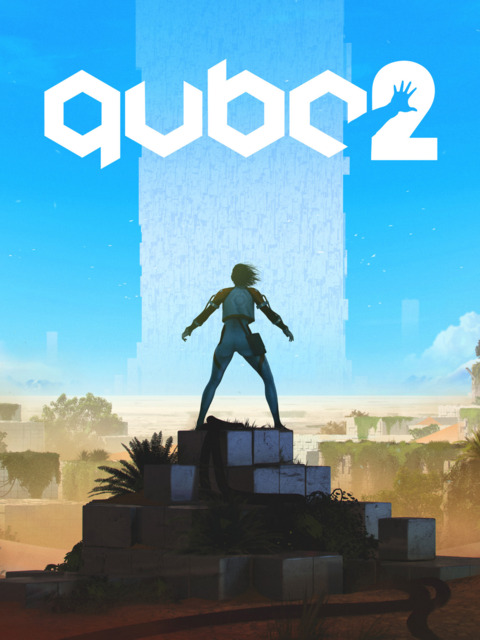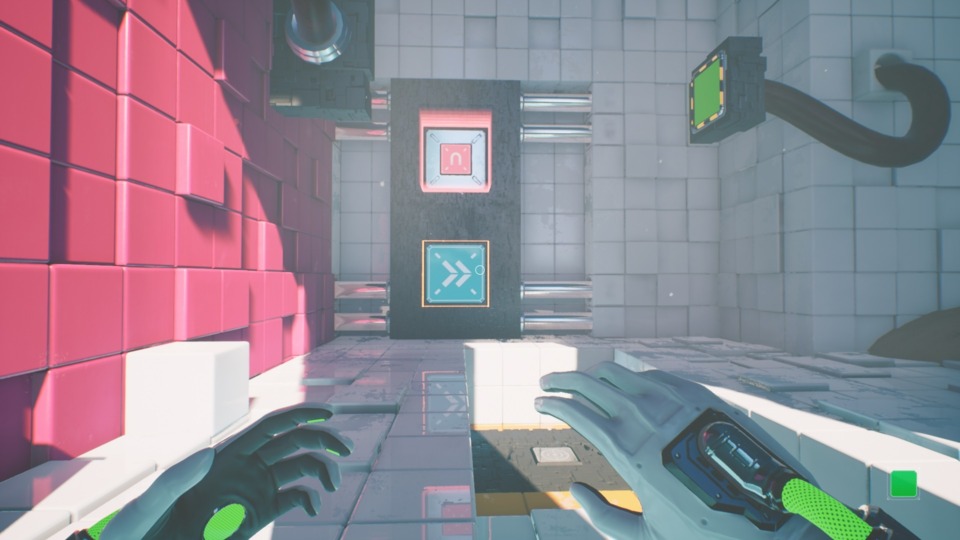Indie Game of the Week 348: Q.U.B.E. 2
By Mento 0 Comments

Hey guys, remember Q.U.B.E.? It's back. Well, OK, so this sequel is already five years old at this point so it's not a recent resurgence, but if there's something I'll always have a soft spot for in this feature—besides the usual RPGs, 3D collectathons, and explormers—it's the humble Portal-alikes, a.k.a. (by no-one) the Dopportalganger. The first Q.U.B.E. was assuredly that, launching in 2011 (as a Desura exclusive!) soon after the eagerly anticipated love letter to lemons and potato PCs that was Portal 2, taking the general structure of a first-person puzzle game that frequently employs physics and momentum in its occasionally vertiginous instances, couching it in a minimalist aesthetic of dilapidated white-tiled rooms that made it easier to identify which parts of the immediate area were relevant to the puzzle at hand (usually the brightly-colored parts), and a little bit of a mystery story that would pipe up to let itself be known between stretches of mentally-taxing, cube-wrangling melon-scramblers.
Q.U.B.E. 2 continues in much the same way as the first, giving you an enigmatic cold open as British researcher Amelia Cross wakes up in an unfamiliar location wearing a pair of high-tech gloves that are beyond anything she recognizes. A friendly radio voiceover, related to the first game, informs her that she's in a location of extraterrestrial origin and her best means of passing through the area is to use said gloves: they're able to activate certain white tiles (they're bordered by danger lines to stand out more, which was conveniently kind of the aliens (though there's a pretty cool in-universe reason for this (they're trying to communicate))) to create blue panels, with other colors to be unlocked later. A blue panel creates a pushing effect that can propel Amelia or any other object a fair distance. Red creates an extended platform that can be climbed on or used to push something else; Green produces a small cube that cannot be picked up but can be stood upon for extra height or used to hold down pressure plates; and so on. The gloves will also activate environmental mechanisms, such as those that might move a panel or produce a magnetic effect. Through this simple assortment of mechanics the player is tasked with moving through a series of rooms in a mostly linear order (there are occasional splits where multiple puzzles are available at once, but the puzzle difficulty is built on a curve so don't expect too much in the way of an open world).

Q.U.B.E. 2 may start simple but it gradually starts to get trickier as its instances demand a greater degree of lateral thinking. However, there's a double-edged sword effect to the more loosey-goosey approach that a physics engine like Q.U.B.E. 2's tends to introduce; there's been a few cases where I've felt like I somehow broke the puzzle and found a much more elusive and unintended means to complete it, maybe by jumping around a platform or utilizing split-second timing on a flying cube to get higher up than I should be. This raises a few questions: Do I feel less satisfied completing a puzzle in this unorthodox way? Shouldn't any success count, and should the developers be condemned or commended for this freedom? Who is to say the strange way I beat that room wasn't the intended route all along, and I'm just overthinking how unintuitive my solution may have felt? It's possibly true of the puzzle genre as a whole that you end up ruminating too much on everything, since you already made the effort of whirring up gears in your brain that maybe don't get too much of a daily workout and now they're free to wreak havoc on your ratiocination. Either way, though I run into this issue often with physics-based games where it seems like I'm finding exploits in the system more than adhering to it, it's not really affecting my enjoyment of the game one way or the other; it just leaves a slightly sour taste in my mouth that something that relies on so much precision could have gaps wide enough to stroll through. Unless, of course, the game is just trying to convince me that I got one over on it...
Anyway, I always dig games like Q.U.B.E. 2 and not just because Portal was such a formative title for both me and the Indie (or at least my definition of Indie, meaning "sufficiently small-scaled and/or low-budget game") market as a whole. There's something to that feeling of walking into a large open room, checking out from every angle all the now-familiar gizmos lining the floors and walls, taking a deep breath, rolling up your sleeves, and getting to work on figuring out how this particular puzzle ticks. Q.U.B.E. 2 might not be doing anything especially novel with its conundrums or its story but it's very competent at creating this very specific type of game with its specific type of environmental stumpers. A stronger narrative hook like Magrunner's or The Talos Principle's might've hit the spot, but the eerie mysteries behind this abandoned facility are starting to ratchet up now at the point I've reached and I don't doubt it has many more mechanisms to introduce. Time to pour another coffee, not forgetting to add a thematically germane sugarQUBE, and get down to business.
Rating: 4 out of 5.
Post-Playthrough Edit: Well, turns out I was fairly close to the end when I stopped to write the review. The story was mostly incidental throughout (the usual voiceover talking heads interrupting some prime "sit there and stew over the puzzles" time) but I did enjoy how it concluded at least. What I've really grown attached to are the game's narrative-free DLC challenges: two sets of puzzle rooms connected by a central hub, all of which (including the hub) have some well-hidden collectibles to find that expands the scope of the puzzles just that little bit further. Some of those collectibles, color-coded by their difficulty to reach, really gave me a mental workout. Definitely keeping the score at a 4: it's the type of game that knows what it is and endeavors to deliver on that promise to the best of its ability, even if it doesn't feel all that revolutionary and its physics occasionally annoy the poop out of me.
| < Back to 347: River City Girls | 001-100 | 101-200 | 201-300 | > Forward to 349: Grime |
